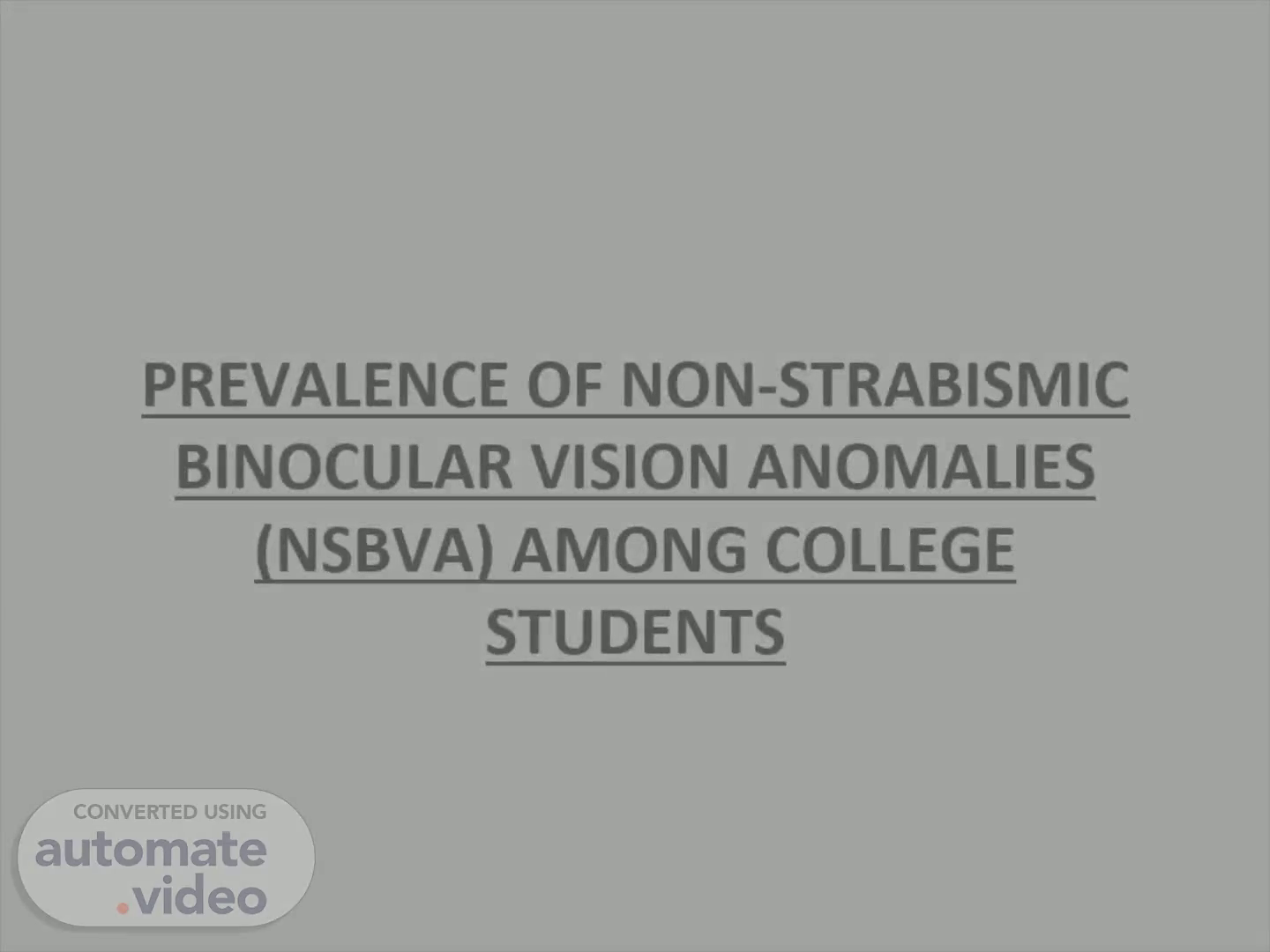
PREVALENCE OF NON-STRABISMIC BINOCULAR VISION ANOMALIES (NSBVA) AMONG COLLEGE STUDENTS
Scene 1 (0s)
PREVALENCE OF NON-STRABISMIC BINOCULAR VISION ANOMALIES (NSBVA) AMONG COLLEGE STUDENTS.
Scene 2 (8s)
LOOKING BEYOND 6/6 !!!!.
Scene 3 (16s)
AIM & OBJECTIVES. AIM: To find out the prevalence of Non-Strabismic Binocular Vision Anomalies among college students (age ranging from 19 to 24) who attended online classes during the COVID-19 Pandemic. OBJECTIVES: To find the prevalence and types of Non-Strabismic Binocular Vision Anomalies among college students. To find out the most common type of Non-Strabismic Binocular Vision Anomaly among college students..
Scene 4 (36s)
METHODOLOGY. METHODOLOGY: STUDY CENTRE: Tertiary care centre. STUDY DESIGN: Cross-sectional study. STUDY PERIOD: 5 Months. SAMPLE SIZE: 80.
Scene 5 (48s)
CRITERIA. INCLUSION CRITERIA: Emmetropic individuals within 19 to 24 years of age. EXCLUSION CRITERIA: Ametropia Amblyopia Strabismus Nystagmus Prior ocular surgery.
Scene 6 (59s)
METHODS. METHODS: Chief complaints and detailed history taking was done. Number of hours of near work/device usage was documented. Complete ocular examination was done with slit lamp bio-microscopy. Complete ophthalmic evaluation was done. Sensory, motor, vergence, accommodation and binocular vision testing was done..
Scene 7 (1m 16s)
Fundus examination was done. Emmetropic individuals were tested for NSBVA. Prevalence of NSBVA was calculated. The types of NSBVA existing among college students were documented. The most common type of NSBVA was found..
Scene 9 (1m 39s)
RESULTS:. RESULTS: Students with ages ranging from 19 to 24 years (mean age 20.31, SD 1.3177) participated in the study. Out of this 23 (28.75%) were male and 57 (71.25%) were female. The prevalence of NSBVA was 33.75% (n=27) and normal binocular vision was 66.25% (n=53)..
Scene 10 (1m 58s)
The Near Point of Convergence ranging from 5 to 14cm (mean NPC 7.3562 and SD 1.9067). In NPC, the mean Break was 6.4 (SD =1.887), and the mean Recovery was 8.3125 (SD=1.9264). The mean Negative Fusional Vergence for distance was 10.075±1.4 (break) and 7.6±1.7 (recovery) and the mean Positive Fusional Vergence were 13.4±1.81 (break) and 10.6±1.77 (recovery). The Near Point of Accommodation was ranging from 5 to 10cm (mean 6.975 and SD 1.1517). The mean Negative Relative Accommodation was +3.11D (SD 0.32) and the mean Positive Relative Accommodation was -4.00D (SD 1.3)..
Scene 11 (2m 32s)
In NSBVA, Non-Strabismic Binocular Convergence anomalies were 21.25% (n=17) and Non-Strabismic Binocular Accommodative Anomalies were 12.25% (n=10)..
Scene 12 (2m 47s)
CONVERGENCE VS ACCOMODATION ANOMALIES. Convergence insufficiency was more prevalent 21.25% (n=17) and the next was Accommodative infacility 8.75% (n = 7) and Accommodative insufficiency 3.75 (n=3)..
Scene 13 (3m 7s)
DISCUSSION. DISCUSSION: The use of visual devices has increased dramatically among college students. The binocular disorders range from constant strabismus with no binocular vision present to non-strabismus binocular anomalies. Additional factors like poor lighting, glare, screen brightness, uncorrected refractive error and improper workstation setup, extended use of visual devices results in different accommodative, vergence dysfunction in a large percentage of the student population..
Scene 14 (3m 28s)
NSBVA are common in an environment of continuous near work. These disorders may occur even in individuals with 6/6 visual acuity. In the present study of binocular dysfunctions, at least 3 out of 10 students had corresponding symptoms that could negatively impact their performance as students. These findings indicate a need to increase the awareness, diagnosis, and management of binocular vision dysfunctions..
Scene 15 (3m 48s)
CONCLUSION. CONCLUSION: Screening for anomalies of binocular vision should be part of the vision screening protocol and appropriate intervention should be planned for non-strabismic anomalies of binocular vision..
Scene 16 (4m 0s)
6/6 IS JUST.
Scene 17 (4m 8s)
REFERENCES. Ghadban R, Martinez JM, Diehl NN, Mohney BG. The incidence and clinical characteristics of adult-onset convergence insufficiency. Ophthalmology. 2015 May;122(5):1056-9. doi: 10.1016/j.ophtha.2014.12.010. Epub 2015 Jan 24. PMID: 25626756; PMCID: PMC4414695. Cacho-Martínez, Pilar & García-Muñoz, Angel & Ruiz, Mª. (2010). Do we really know the prevalence of accomodative and nonstrabismic binocular dysfunctions?. Journal of Optometry. 3. 185-197. 10.1016/S1888-4296(10)70028-5. Hussaindeen JR, Rakshit A, Singh NK, Swaminathan M, George R, Kapur S, Scheiman M, Ramani KK. Binocular vision anomalies and normative data (BAND) in Tamil Nadu: report 1. Clin Exp Optom. 2017 May;100(3):278-284. doi: 10.1111/cxo.12475. Epub 2016 Oct 30. PMID: 27796049. Rouse M, Borsting E, Mitchell GL, Kulp MT, Scheiman M, Amster D, Coulter R, Fecho G, Gallaway M; CITT Study Group. Academic behaviors in children with convergence insufficiency with and without parent-reported ADHD. Optom Vis Sci. 2009 Oct;86(10):1169-77. doi: 10.1097/OPX.0b013e3181baad13. PMID: 19741558; PMCID: PMC2888729. Borsting E, Mitchell GL, Kulp MT, Scheiman M, Amster DM, Cotter S, Coulter RA, Fecho G, Gallaway MF, Granet D, Hertle R, Rodena J, Yamada T; CITT Study Group. Improvement in academic behaviors after successful treatment of convergence insufficiency. Optom Vis Sci. 2012 Jan;89(1):12-8. doi: 10.1097/OPX.0b013e318238ffc3. PMID: 22080400; PMCID: PMC3261761..